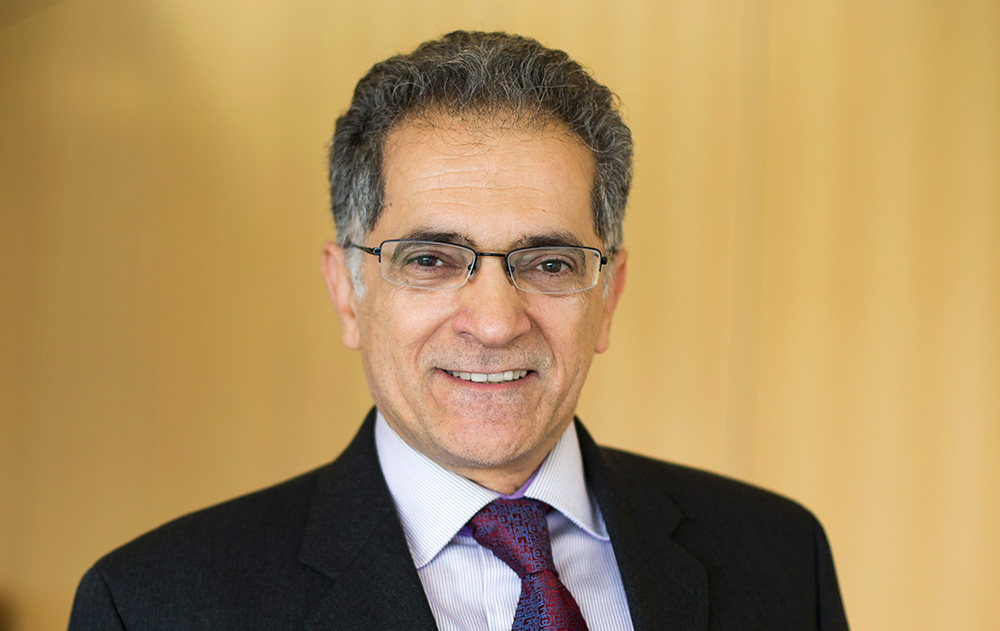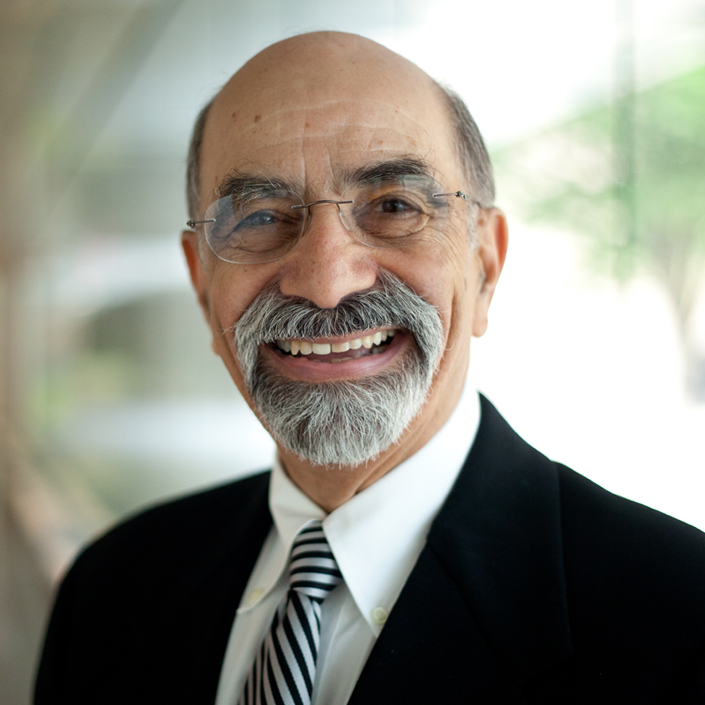
Kamal Sarabandi named Fawwaz T. Ulaby Distinguished University Professor of EECS
Prof. Sarabandi has distinguished himself as an educator, researcher, and inventor with wide-ranging impact

Prof. Sarabandi has distinguished himself as an educator, researcher, and inventor with wide-ranging impact

Kamal Sarabandi has been named the Fawwaz T. Ulaby Distinguished University Professor of Electrical Engineering and Computer Science for his outstanding contributions to the University as a researcher, educator, and leader.
The Distinguished University Professorship, established in 1947, is the University’s most prestigious professorship. Awardees are given the opportunity to determine the name of the professorship, and Sarabandi took the name of his former doctoral advisor and mentor – Fawwaz Ulaby.
“Fawwaz personifies an ideal university professor as an educator, scientist, and leader who has demonstrated enormous contributions to the field of Applied Electromagnetics,” said Sarabandi. “His service and dedication to the University of Michigan has been exemplary. I am very proud and honored by having my Professorship named after him.”
When Sarabandi received his doctoral degree from Michigan in 1989, he had already demonstrated pioneering work in the use of imaging radar systems for monitoring vegetation at the global scale. His continuing collaboration with Ulaby and others resulted in the Michigan Microwave Canopy Scattering model (MIMICS) and other algorithms and theoretical models that are considered classics and used by remote sensing practitioners even today.
He contributed to the Shuttle Imaging Radar that flew on NASA’s Shuttle Imaging Radar-C (SIR-C) mission in 1994, the most advanced radar system to ever fly in space at the time. Later he was involved in the Shuttle Radar Topography Mission (SRTM), which provided data to generate the first nearly global, high-accuracy topographical map of the Earth. The shuttle was launched aboard the Space Shuttle Endeavor on Feb. 11, 2000. The calibration techniques Sarabandi used to validate the map are now the standard approach used worldwide.
More recently, Sarabandi and his team constructed the most powerful radar calibration device in the world to interface with NASA’s newest orbiting satellite, called Soil Moisture Active Passive (SMAP), which launched Jan. 31, 2015. SMAP’s mission is to map worldwide surface soil moisture, which will enhance our understanding of weather and climate, while improving our ability to predict weather patterns. He received the NASA Group Achievement Award for his contributions to SMAP.
A researcher with endless curiosity, Sarabandi established an electromagnetic metamaterials program in 2000 in collaboration with the Materials Science & Engineering Department under a MURI DARPA program. Through this five-year program, novel magneto-dielectric, circuit-embedded, electromagnetic band-gap, reactive impedance surfaces and metasurfaces for antenna miniaturization were demonstrated for the first time.
Sarabandi served as Director of the Center for Objective Microelectronics and Biomimetic Advanced Technology (COMBAT) between 2008-2018, funded by the Army Research Lab’s Micro-Autonomous Systems and Technology (MAST) program. Over its 10 year history, the Center developed next-generation technologies for sensing, information processing, navigation, control, and communication, all focused on miniature-size ground and airborne robots. The technology developed was transferred successfully to industry.
He currently serves as Director of the Center of Excellence for Microwave Sensor Technology, which is focused on designing the next generation of automotive radar. Additional research happening in the Center includes subsurface imaging of buried objects; compact and low-power THz integrated circuits for hidden object detection in airports as well as detection of cracks in industrial settings; and wireless power transfer.
Sarabandi maintains a large research group, and his students are recipients of literally dozens of prestigious fellowships and paper awards. He has chaired or co-chaired 58 doctoral theses.
A proven leader, Sarabandi has impacted policy through his long-standing service on the NASA Advisory Council. He has served as President of the IEEE Geoscience and Remote Sensing Society, and Chair of Commission F, United States National Committee for The International Union of Radio Science (USNC/URSI). At Michigan, he served as Director of the Radiation Laboratory between 2000-2021.
He holds 19 U.S. patents and is co-founder of four startup companies: EMAG Technologies, Gradient Technologies LLC (acquired in 2002), Opteos LLC, and Navisense, Inc. These companies have contributed more than $100M to the local economy.
Sarabandi is a Member of the National Academy of Engineering and a Fellow of the National Academy of Inventors, the American Association for the Advancement of Science (AAAS), and IEEE. He has received the IEEE Judith A. Resnik Field Award, IEEE Geoscience and Remote Sensing Society Distinguished Achievement Award, and IEEE Geoscience and Remote Sensing Society Education Award. He was named Rufus S. Teesdale Endowed Professor of Engineering in 2009.
Prof. Sarabandi will present a special lecture in honor of being named the Fawwaz U. Ulaby Distinguished University Professor.

Fawwaz T. Ulaby is an internationally renowned researcher in the fields of terahertz technology and microwave remote sensing.
Ulaby, who designed the first radar to fly in space, served as the founding Director of the NASA-funded Center for Space Terahertz Technology, as well as other large, interdisciplinary NASA projects aimed at the development of high-resolution satellite radar sensors for mapping earth’s terrestrial environment. These remote sensing systems now fly aboard satellites operated by NASA as well as the European, Canadian, and Japanese space agencies.
His remarkable contributions to the field of engineering education and research have been recognized with numerous honors, including election to the National Academy of Engineering, as well as the IEEE Edison Medal, IEEE Electromagnetics Award, the William T. Pecora Award (for shaping the direction of the space program in microwave remote sensing), the James H. Mulligan, Jr. Education Medal, the IEEE GRSS Education Award, the HKN C. Holmes MacDonald Outstanding Teaching Award, and many more.
Ulaby’s dedication to the education of students is legendary at Michigan, and led to him receiving the HKN Teacher of the Year award three times. He has published 16 books, including the highly successful Fundamentals of Applied Electromagnetics, and initiated the Free Electrical Engineering Textbook Initiative, which already has saved an estimated $10M in textbook costs to students.
As a leader in the professional community, Prof. Ulaby’s influence has been far-reaching. He served as founding President of the IEEE Geoscience and Remote Sensing Society, as Editor-In-Chief of the Proceedings of the IEEE, and as Vice President for Research at the University of Michigan. More recently, he was founding Provost and Executive Vice President for Academic Affairs of the King Abdullah University of Science and Technology (KAUST) in Saudi Arabia. In addition, he serves on the National Academies Committee on Human Rights.
Ulaby retired from the University of Michigan in 2021 as the Emmett Leith Distinguished University Professor of EECS, Chen-To Tai Professor of Engineering, and Arthur F. Thurnau Professor.